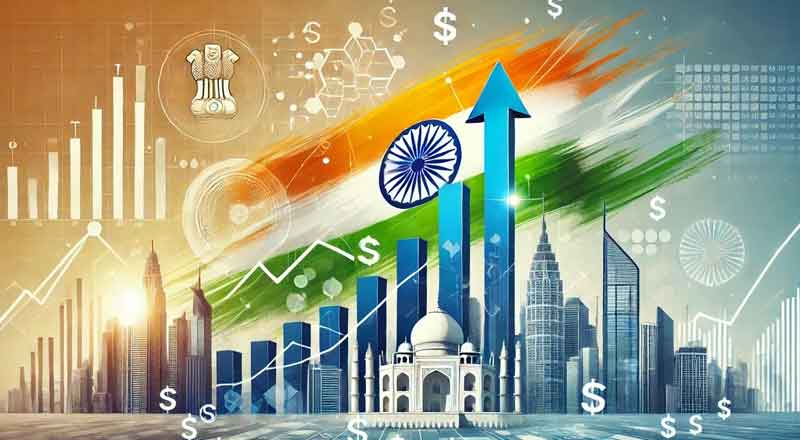India’s Economic Momentum
India’s economy has emerged as a beacon of resilience and growth in the global landscape, showcasing robust expansion driven by private consumption, investment, and strategic policy initiatives. Amid global economic uncertainties, India has maintained a strong growth trajectory, reflecting its transformation into a powerhouse of manufacturing, services, and digital innovation. According to a recent UN report, India’s GDP is projected to grow at 6.6% in 2025, solidifying its position as the largest and fastest-growing economy in South Asia.
Economic Growth Backed by Strong Fundamentals
The UN World Economic Situation and Prospects 2025 highlights India’s economic potential, underpinned by strong private consumption and infrastructure investments. The Indian economy, which grew by 6.8% in 2024, is forecasted to expand at 6.6% in 2025 and return to 6.8% by 2026. These figures underscore the resilience of India’s economic model, supported by robust public and private sector initiatives.
Capital expenditure on infrastructure development is expected to play a pivotal role in fuelling growth. Investments in physical and digital connectivity, as well as social infrastructure projects like water supply and sanitation, are projected to have a multiplier effect on economic activity. On the supply side, the expansion of the manufacturing and services sectors, coupled with export growth in pharmaceuticals and electronics, will bolster economic momentum.
Favourable monsoon rains in 2024 have also boosted agricultural output expectations, further supporting rural consumption and economic stability.
Past Successes: Lessons from Recent Achievements
India’s ability to navigate economic challenges has been tested in the past. For instance, during the COVID-19 pandemic, India’s swift policy responses, such as the Atmanirbhar Bharat initiative, provided a safety net for businesses and individuals. Investments in technology and innovation helped maintain continuity and laid the groundwork for long-term resilience.
In 2023, the introduction of production-linked incentives (PLI) in sectors such as electronics and renewable energy attracted significant foreign direct investment (FDI), positioning India as a global manufacturing hub. These efforts have enabled India to maintain a steady growth trajectory despite global headwinds, such as geopolitical tensions and supply chain disruptions.
Inflation and Employment Trends
India’s inflation is expected to decelerate from 4.8% in 2024 to 4.3% in 2025, staying within the Reserve Bank of India’s target range of 2–6%. While decreasing energy prices have contributed to this decline, adverse weather conditions have occasionally spiked food prices.
Employment indicators in India have remained strong, with urban unemployment stabilizing at 6.6% in 2024, a marginal improvement from 6.7% in 2023. However, challenges remain, particularly in bridging gender gaps in labor force participation.
South Asia and India’s Role
South Asia’s economic outlook is projected to grow at 5.7% in 2025, driven largely by India’s performance. The region has faced climate-related challenges, including heatwaves, droughts, and irregular rainfall, which have disrupted agricultural yields and widened income inequalities. India’s focus on renewable energy and sustainable practices will be critical in mitigating these risks.
In comparison, other economies in the region, such as Bhutan, Nepal, and Sri Lanka, are showing signs of recovery. However, political turmoil and debt challenges in some South Asian countries could weigh on the region’s overall growth.
Global Economic Context
India’s growth is expected to outpace that of China, whose economy is projected to moderate to 4.8% in 2025 due to subdued consumption and property sector challenges. Globally, economic growth is forecasted at 2.8% in 2025, with India and Indonesia standing out as bright spots among developing nations.
Toward a Sustainable and Inclusive Future
India’s economy is on a promising trajectory, driven by strong domestic demand, strategic investments, and a focus on innovation. However, challenges such as climate risks, gender disparities in the labor market, and external geopolitical uncertainties remain.
The government’s emphasis on infrastructure development, digital transformation, and renewable energy positions India as a leader in sustainable growth. By addressing structural issues and fostering inclusivity, India can ensure that its economic resurgence benefits all sections of society.
As the world grapples with slower growth, India’s economic story serves as a testament to the potential of strategic policymaking, resilience, and the power of a billion-strong workforce. The road ahead is paved with opportunities, and with continued focus and innovation, India is poised to solidify its status as a global economic powerhouse.





